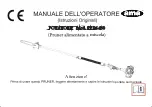
20
| English
u
Hold the power tool by insulated gripping surfaces,
when performing an operation where the cutting tool
may contact hidden wiring.
Contact with a "live" wire
will also make exposed metal parts of the power tool "live"
and could give the operator an electric shock.
u
When ripping always use a rip fence or straight edge
guide.
This improves the accuracy of cut and reduces the
chance of blade binding.
u
Always use blades with correct size and shape (dia-
mond versus round) of arbour holes.
Blades that do not
match the mounting hardware of the saw will run off-
centre, causing loss of control.
u
Never use damaged or incorrect blade washers or
bolt.
The blade washers and bolt were specially designed
for your saw, for optimum performance and safety of op-
eration.
Kickback causes and related warnings
- kickback is a sudden reaction to a pinched, jammed or mis-
aligned saw blade, causing an uncontrolled saw to lift up and
out of the workpiece toward the operator;
- when the blade is pinched or jammed tightly by the kerf
closing down, the blade stalls and the motor reaction drives
the unit rapidly back toward the operator;
- if the blade becomes twisted or misaligned in the cut, the
teeth at the back edge of the blade can dig into the top sur-
face of the wood causing the blade to climb out of the kerf
and jump back toward the operator.
Kickback is the result of saw misuse and/or incorrect operat-
ing procedures or conditions and can be avoided by taking
proper precautions as given below.
u
Maintain a firm grip with both hands on the saw and
position your arms to resist kickback forces. Position
your body to either side of the blade, but not in line
with the blade.
Kickback could cause the saw to jump
backwards, but kickback forces can be controlled by the
operator, if proper precautions are taken.
u
When blade is binding, or when interrupting a cut for
any reason, release the trigger and hold the saw mo-
tionless in the material until the blade comes to a com-
plete stop. Never attempt to remove the saw from the
work or pull the saw backward while the blade is in
motion or kickback may occur.
Investigate and take cor-
rective actions to eliminate the cause of blade binding.
u
When restarting a saw in the workpiece, centre the
saw blade in the kerf so that the saw teeth are not en-
gaged into the material.
If a saw blade binds, it may walk
up or kickback from the workpiece as the saw is restar-
ted.
u
Support large panels to minimise the risk of blade
pinching and kickback.
Large panels tend to sag under
their own weight. Supports must be placed under the
panel on both sides, near the line of cut and near the edge
of the panel.
u
Do not use dull or damaged blades.
Unsharpened or im-
properly set blades produce narrow kerf causing excess-
ive friction, blade binding and kickback.
u
Blade depth and bevel adjusting locking levers must
be tight and secure before making the cut.
If blade ad-
justment shifts while cutting, it may cause binding and
kickback.
u
Use extra caution when sawing into existing walls or
other blind areas.
The protruding blade may cut objects
that can cause kickback.
Lower guard function
u
Check the lower guard for proper closing before each
use. Do not operate the saw if the lower guard does
not move freely and close instantly. Never clamp or tie
the lower guard into the open position.
If the saw is ac-
cidentally dropped, the lower guard may be bent. Raise
the lower guard with the retracting handle and make sure
it moves freely and does not touch the blade or any other
part, in all angles and depths of cut.
u
Check the operation of the lower guard spring. If the
guard and the spring are not operating properly, they
must be serviced before use.
Lower guard may operate
sluggishly due to damaged parts, gummy deposits, or a
build-up of debris.
u
The lower guard may be retracted manually only for
special cuts such as "plunge cuts" and "compound
cuts”. Raise the lower guard by the retracting handle
and as soon as the blade enters the material, the lower
guard must be released.
For all other sawing, the lower
guard should operate automatically.
u
Always observe that the lower guard is covering the
blade before placing the saw down on bench or
floor.
An unprotected, coasting blade will cause the saw
to walk backwards, cutting whatever is in its path. Be
aware of the time it takes for the blade to stop after
switch is released.
Additional safety warnings
u
Do not allow the chip ejector to come into contact with
your hands.
You may be injured by rotating parts.
u
Do not use the saw above the level of your head.
Doing
so will mean you have inadequate control of the power
tool.
u
Use suitable detectors to determine if there are hid-
den supply lines or contact the local utility company
for assistance.
Contact with electric cables can cause
fire and electric shock. Damaging gas lines can lead to ex-
plosion. Breaking water pipes causes property damage.
u
Hold the power tool firmly with both hands and make
sure you have a stable footing.
The power tool can be
more securely guided with both hands.
u
Do not operate the power tool when stationary .
It is
not suitable for operation with a saw table.
u
When performing plunge cuts which are not right-
angled, secure the guide plate of the saw so that it will
not shift sideways.
In the event of a sideways shift, the
saw blade may become jammed, which could lead to kick-
back.
1 609 92A 5FB | (24.02.2020)
Bosch Power Tools
















































